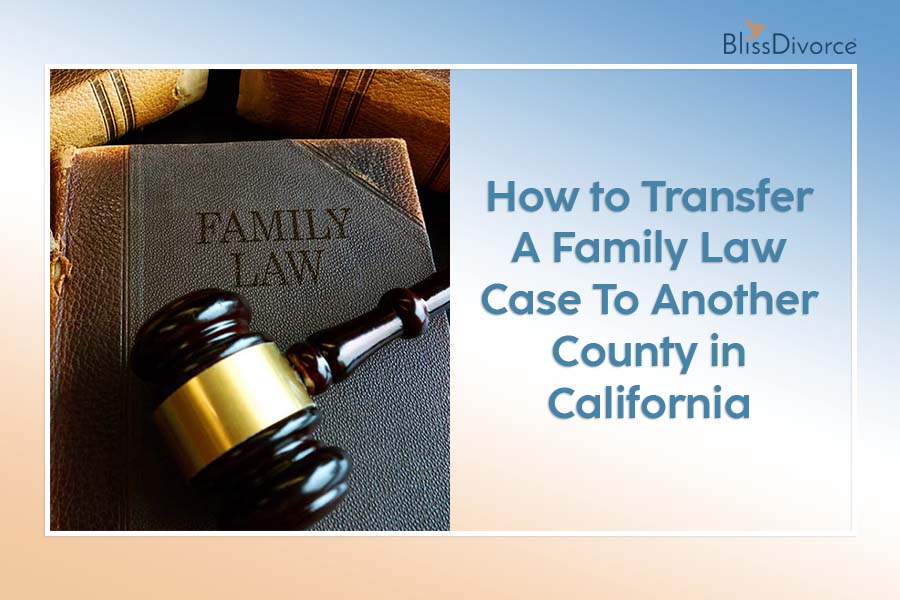Please note that all online divorce platforms are not the same. Much of the content below does not apply to BlissDivorce. BlissDivorce is the only complete online divorce solution, including property division, child custody, spousal support, and AI-powered Digital Divorce Mediation.
Navigating the intricacies of family law proceedings can be challenging. You will need to familiarize yourself with key concepts and address legal matters like child custody, marital property, and alimony. But what happens if the location you choose is no longer convenient? If you wonder how to transfer a family law case to another county in California, you need to understand the requirements involved.
If you search for a different jurisdiction but don’t know where to start, continue reading. In this guide, we will give you valuable insights to navigate this aspect of the legal system confidently.
How to Transfer a Family Law Case to Another County in California
If you wonder how to transfer a case from one county to another, the process involves making life-changing decisions and complying with California’s laws. To navigate the legal landscape successfully, you can request California divorce advice by consulting legal professionals.
Family law matters take time to resolve, often lasting for months to a year. During this time, many changes can occur. Maybe you or your spouse will move to another county. But can you transfer a court case to another county? The answer is yes; you can change the venue of your case in the Golden State.
To transfer the case, you must file a motion for a change of venue (request for order) with the court where your case is currently filed. The court will then consider your motion along with your supporting declaration.

Source: shutterstock.com / Photo Contributor: zimmytws
Legal basis for the transfer
The legal grounds for transferring a family law case in the state of California are established by relevant statutes such as the California Code of Civil Procedure sections 392 and 395. They state the circumstances under which the court may grant a venue change.
Based on the California Code of Civil Procedure (section 397.5), the court where you have filed your case will approve the transfer in the following cases:
- The individual who initially filed the case chose the wrong location.
- If one or both of you have moved out of the county.
- Both of you approve the transfer of the case.
- Continuing the case in the current country can lead to an unfair trial.
- The venue doesn’t have a qualified judge to hear your case.
- The county you live in is better suited for your family law case.
- Avoiding bias or conflict of interest to ensure fairness.
When both you and your spouse agree to the change of venue, the hearing process will likely be straightforward. However, if one of you disagrees with the change, we should note that the process can become complex.
Reasons for transferring a family law case
The reasons for transferring a family law case can differ. If you or your spouse have moved to another county, transferring the proceedings may be necessary to accommodate the new circumstances.
You may also request a transfer to a county where facilities are conveniently located. Doing so can reduce travel time and logistical challenges associated with attending meetings and hearings.
In cases with concerns regarding impartiality or conflict of interest within the jurisdiction, transferring the case can ensure a fair and unbiased resolution. When the court decides whether to approve such a transfer, it takes into consideration:
- The residence of you and your spouse, the witnesses, and children.
- The physical location of the evidence associated with the case.
- The convenience of the location for everyone involved.
Initiating the Transfer Process
To initiate the transfer of a family law case to another county, you must file the necessary paperwork within the court in which it is currently filed. This generally involves filing and submitting a motion for change of venue California family law and providing a supporting declaration.
In the declaration, you must state why you requested to move your case to another county. A well-written declaration might be a key to receiving approval for changing the venue of your case. You must file the motion with the court where your family law case was initially filed.
Once you send your motion, you must notify your spouse, who can file a response if they oppose the decision. In addition, you may also provide supporting documentation and evidence to justify the transfer. Such documents may include proof of a change of residence, like utility bills or a lease agreement, providing evidence supporting the necessity of the relocation.
Court procedures and hearings
Upon receiving the transfer request, the court reviews the motion and the supporting documentation. During the review process, this institution determines whether there are valid grounds for the case transfer. The court’s reviewing also typically involves scheduling a hearing date to consider the request.
You and your spouse may need to answer the judge’s questions and present arguments supporting the transfer during the hearing. Once the order is approved, you can continue the case to the new county. However, remember that you must pay a first appearance court filing fee.
The court will schedule hearings and appearances following its calendar and procedural requirements. This means you should be prepared to attend these proceedings and adhere to any deadlines set by the court for filing additional documents or providing further evidence if necessary.

Source: shutterstock.com / Photo Contributor: Studio Romantic
Possible objections and addressing them
During the hearing, the court may address objections if the other party opposes the transfer. They may object on various grounds, such as disputing the validity of the reasons provided or asserting that the current jurisdiction is appropriate for the case.
However, they must provide counter arguments and evidence to refute opposing claims. This may involve presenting additional documentation or testimony to demonstrate a necessity for the fair and efficient resolution of the case.
Conclusion
We explored how to transfer a family law case to another county in California if the location is no longer suitable. Navigating a transfer request’s court procedures and hearings requires careful preparation and adherence to procedural rules for a favorable outcome. By following the established process and presenting compelling arguments, you can increase your chances of approval.




